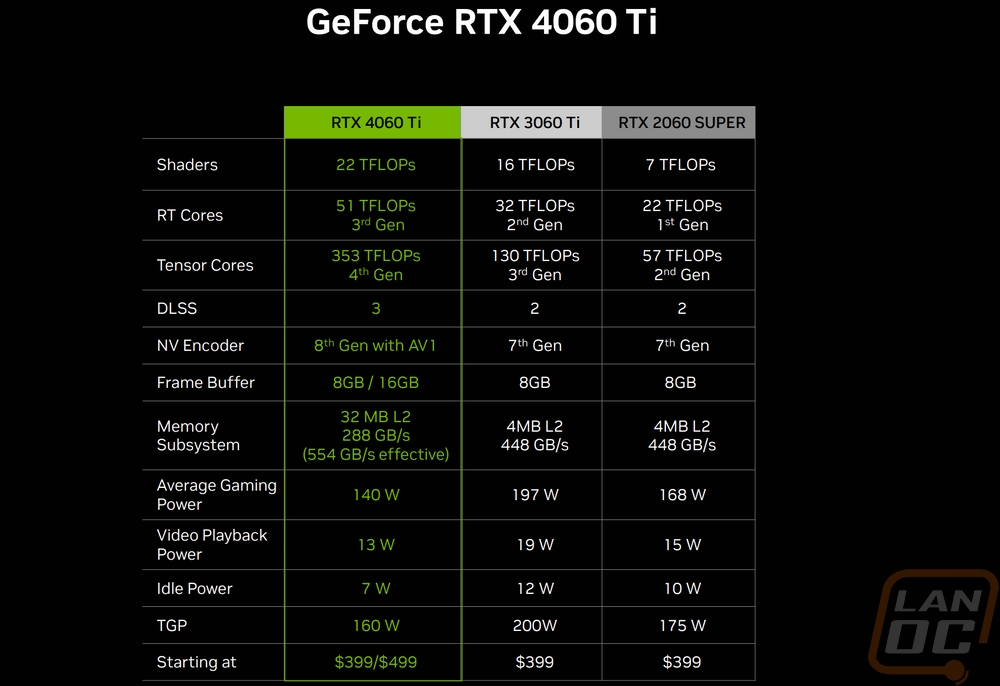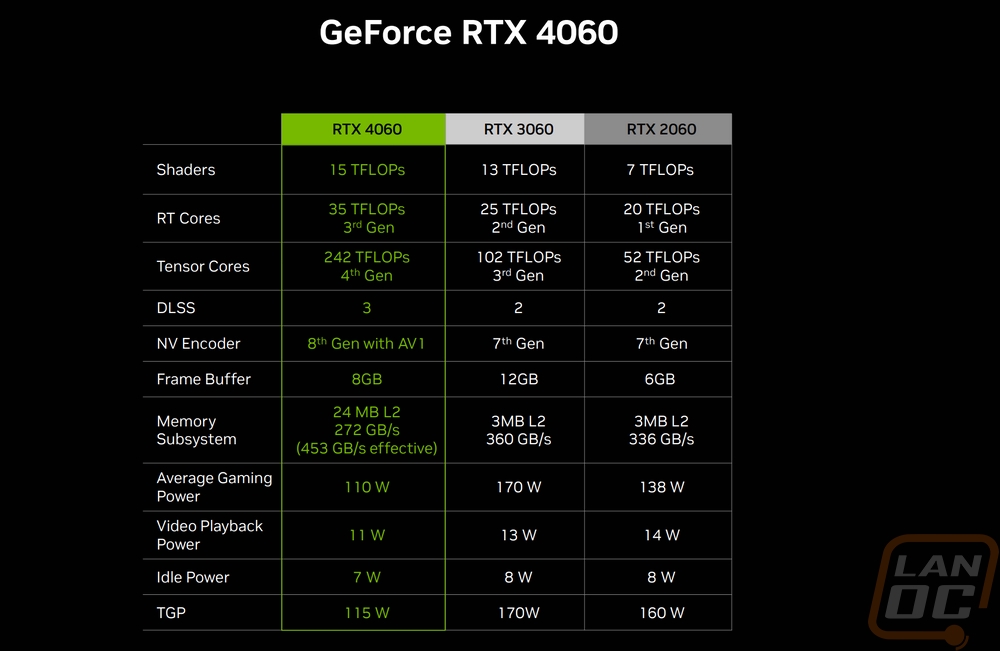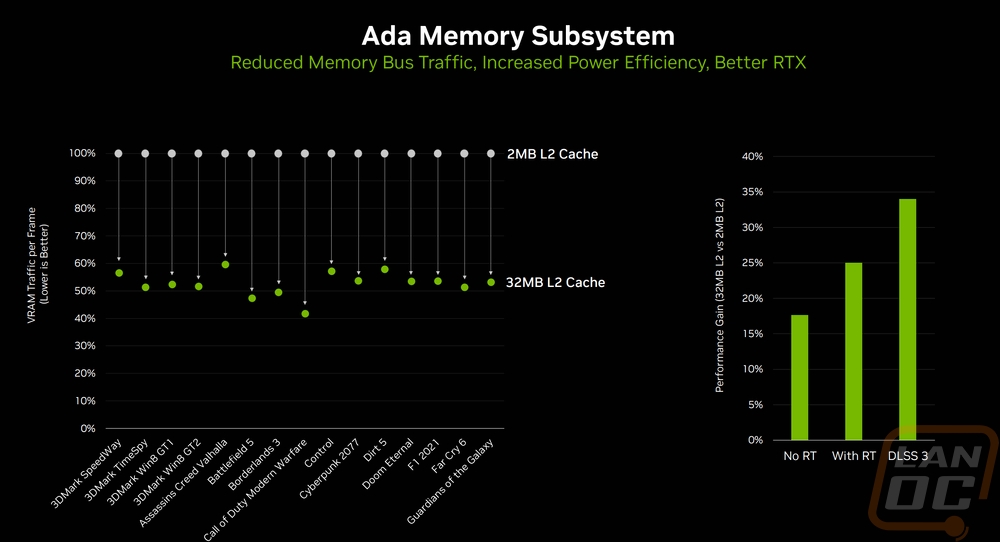With every new generation of video cards, the latest and greatest cards are always exciting. But the truth is most people aren’t gaming at the resolutions needed to justify those cards. The latest Steam hardware survey has just 2.75% of users running a 4K display, 1440p is gaining ground at 12.49% of users. But it is still 1080p that is the most used resolution with an impressive 64.52% of users. That tells us that the power users may benefit from the highest-end cards, but for a while longer a majority of people will be better served with the mid-range of the newer lineup and we are finally starting to get into that with Nvidia’s recent announcement of the RTX 4060 Ti 8GB, RTX 4060 Ti 16GB, and the RTX 4060. The RTX 4060 Ti 16GB and the RTX 4060 are scheduled for release in July, but the RTX 4060 Ti itself will be in stores tomorrow. So today I’m going to dive into the details on the card, check out the design of the Founders Edition card, and then put it to the test to see how it fits in the market right now.
Product Name: Nvidia RTX 4060 Ti Founders Edition
Review Sample Provided by: Nvidia
Written by: Wes Compton
Amazon Affiliate Link: HERE
RTX 4060 Ti, what’s that?
Nvidia announced not only the RTX 4060 Ti that we are checking out today, but also the RTX 4060 and a second RTX 4060 with 16GB of memory. All three cards continue their 4000 Series of cards which are based on the Nvidia Ada Lovelace architecture. Ada Lovelace had a big focus on expanding even more Ray Tracing capabilities with their 3rd generation of RT Cores as well as deep learning or AI with the 4th generation Tensor cores. The new Tensor Cores helping support DLSS 3 which continues to expand and improve on Nvidia’s Deep Learning Super Sampling technology with the addition of Frame Generation. DLSS 3 with frame generation uses the tensor cores to take load off of the CUDA and RT cores, combined with frame generation 7 out of 8 frames are rendered by the AI allowing for huge performance gains. DLSS 3 has had a good adoption rate as well as far as games go with games like the new Lord of the Rings game including it and Diablo 4 as well. Obviously, this tech is only as good as the number of games that use it, so I’m glad to see that is still ramping up.


Of the three new cards, the RTX 4060 Ti 8GB that we have here today launches tomorrow May 24th with the two other cards coming in July according to Nvidia.

To look at the specifications of the new RTX 4060 Ti I have also put it next to the RTX 3060 Ti from the last generation and the RTX 4070 so we can see how it compares to the next card up. The 4060 Ti has a full GPC less than the 4070 which translates down the full specifications with everything being close to ¾ of the 4070, like the CUDA core count being 4352 to the 5888. It’s interesting to see how the 4060 Ti is down in CUDA cores compared to the 3060 Ti, Nvidia makes up for that in clock speed however with the 4060 Ti having a boost clock of 2535 to the 1665 MHz of the 3060 Ti as well as with the memory being clocked faster as well. The big Ada L2 Cache improvement can be seen, the 4060 Ti has 32 MB to 4 MB. The 4060 Ti that we have here today has the same 8 GB of GDDR6 that the 3060 Ti launched with. But the 4060 Ti has a much smaller memory interface with it being 128-bit to the 256-bit on the 3060 Ti and 192-bit for the RTX 4070. You can see this again with the total memory bandwidth numbers of just 288 GB/s for the 4060 Ti. Nvidia’s specifications also note that they consider this to be 554 GB/s effective because of the larger L2 Cache. The RTX 4060 Ti, while looking like a cut down RTX 4070 does have a new chip and that can be seen in the transistor count which is down from 35.8 billion on the 4070 to 22.9 Billion on the 4060 Ti. With that, they have the TGP down to 160 watts compared to the 200 watts for both of the other cards.
|
Specifications |
RTX 3060 Ti |
RTX 4060 Ti |
RTX 4070 |
|
Graphics Processing Clusters |
5 |
3 |
4 |
|
Texture Processing Clusters |
19 |
17 |
23 |
|
Streaming Multiprocessors |
38 |
34 |
46 |
|
CUDA Cores |
4864 |
4352 |
5888 |
|
Tensor Cores |
152 (3rd Gen) |
136 (4th Gen) |
184 (4th Gen) |
|
RT Cores |
38 (2nd Gen) |
34 (3rd Gen) |
46 (3rd Gen) |
|
Texture Units |
152 |
136 |
184 |
|
ROPs |
80 |
48 |
64 |
|
Boost Clock |
1665 MHz |
2535 MHz |
2475 MHz |
|
Memory Clock |
7000 MHz |
9000 MHz |
1313 MHz |
|
Memory Data Rate |
14 Gbps |
18 Gbps |
21 Gbps |
|
L2 Cache Size |
4 MB |
32 MB |
36 MB |
|
Total Video Memory |
8 GB GDDR6 / 8 GB GDDR6X |
8 GB GDDR6 |
12 GB GDDR6X |
|
Memory Interface |
256-bit |
128-bit |
192-bit |
|
Total Memory Bandwidth |
448 GB/s |
288 GB/s |
504 GB/sec |
|
Texture Rate (Bilinear) |
253.1 GigaTexels/sec |
345 Gigatexels/sec |
455.4 Gigatexels/sec |
|
Fabrication Process |
Samsung 8 nm 8N NVIDIA Custom Process |
TSMC 4N NVIDIA Custom Process |
TSMC 4N NVIDIA Custom Process |
|
Transistor Count |
17.4 billion |
22.9 Billion |
35.8 billion |
|
Connectors |
3x DisplayPort 1 x HDMI
|
3x DisplayPort 1 x HDMI |
3 x DisplayPort 1 x HDMI |
|
Power Connectors |
1x PCIe 8-pin (adapter to 1x 12-pin included) |
PCIe 8-pin cable (adapter in box) OR 300 W or greater PCIe Gen 5 cable |
2x PCIe 8-pin cables OR 300w or greater PCIe Gen 5 cable |
|
Minimum Power Supply |
600 Watts |
550 Watts |
650 Watts |
|
Total Graphics Power (TGP) |
200 Watts |
160 Watts |
200 Watts |
|
Maximum GPU Temperature |
93° C |
90° C |
90° C |
|
PCI Express Interface |
Gen 4 |
Gen 4 |
Gen 4 |
|
Launch MSRP |
$399 |
$399 |
$599 |
Nvidia’s spec breakdown of the RTX 4060 Ti compared its numbers with the RTX 3060 Ti just like I did as well as the RTX 2060 SUPER which would be the comparable model from two generations ago. A lot of people look to upgrade every other generation, so this is a good comparison to include and it shows an even bigger improvement with the shader performance going from 7 TFLOPs to 22 TFLOPs. They also have the same breakdown for the RTX 4060 which I’m not checking out today comparing it with the RTX 3060 and the RTX 2060.


There has been a LOT of talk recently about VRAM and you can see that with Nvidia including a 16GB version of the RTX 4060 Ti in their upcoming cards. Their presentation did also touch on how Ada has changed their memory subsystems to improve efficiency. They did this with the big jump in L2 Cache size which they are showing that it cuts down on the need for a larger memory bus, the L2 Cache handling some of that traffic right on the chip. This does help explain the RTX 3060 Ti having a 256-bit bus whereas the RTX 4060 Ti has 128-bit. You have to go back to the GTX 960 which was the last time a x60 card had a 128-bit memory bus so I do understand the concern.

Before getting into testing I did also run GPUz to double-check that our clock speeds match up with the specifications. Our card was running at the correct 2535 MHz boost clock and 2310 base clock so no issues there. The BIOS revision is noted in case there are any future changes as well as our driver which is the 531.93 BIOS driver provided to press ahead of the launch.


